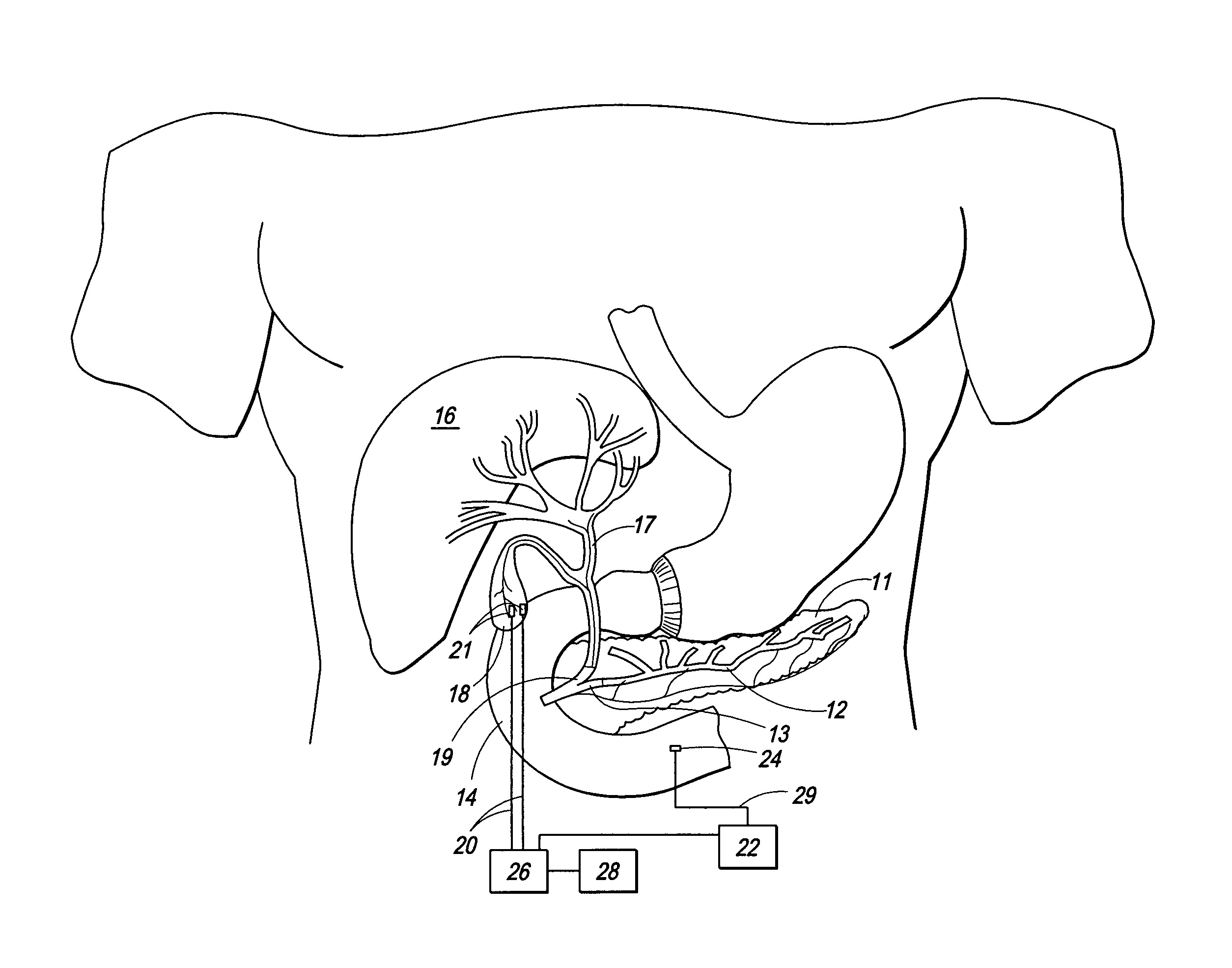Method and apparatus for electrical stimulation of the pancreatico-biliary system
a technology of pancreatic and biliary system, applied in the field of method and apparatus for electrical stimulation of the pancreaticobiliary system, can solve the problems of cumbersome bile salts, ineffectiveness, and significant morbidity mortality, and achieve the effect of modulating the secretions of bil
- Summary
- Abstract
- Description
- Claims
- Application Information
AI Technical Summary
Benefits of technology
Problems solved by technology
Method used
Image
Examples
example one
[0044]In one exemplary application, a forty-five year old female complains of right upper quadrant pain for the last 6 months. The pain is exacerbated by meals, mainly fatty meals. She has a family history of gall bladder cancer. An ultrasound reveals that she has gall bladder sludge. A HIDA scan (cholescintigraphy) showed poor gall bladder ejection fraction.
[0045]To alleviate those symptoms and reduce gall bladder sludge, the patient undergoes the laproscopic implantation of a gall bladder stimulator. The stimulator leads are implanted in the fundus of gall bladder and the microcontroller is implanted in a pocket in the anterior abdominal wall. An external microcontroller could have been used instead and worn on the patient's belt, together with a charger that charges the microstimulator via RF signaling.
[0046]To active the stimulator, the patient uses a remote control that signals to the microcontroller when the patient ingests a meal. Based on patient's gastric emptying time, the...
example two
[0051]In a second exemplary application, a thirty five year old male weighing 412 lbs, with a body mass index of 42, is referred to a surgeon for a bariatric procedure. The patient suffers from insulin dependent diabetes mellitus, moderate hypertension, obstructive sleep apnea and high cholesterol. The patient undergoes a laparoscopic implantation of the bile duct stimulator. The stimulator leads are implanted on the serosal surface of the distal bile duct and the microcontroller is implanted in a pocket in the anterior abdominal wall. Alternatively, the microstimulator could have been laproscopically or endoscopically implanted in the distal bile duct with the external microcontroller worn on the patient's belt to charge the microstimulator via RF signaling.
[0052]Using remote control signals, the patient signals the ingestion of a meal. Based on patient's desired weight loss, the microcontroller sends multiple trains of pulses after a preset time delay. In this particular patient, ...
example three
[0058]In a third exemplary application, a fifty five year old female weighing 265 lbs, with a body mass index of 35, is referred to a surgeon for a bariatric procedure. The patient suffers from insulin dependent diabetes mellitus, moderate hypertension, obstructive sleep apnea, degenerative joint disease, reflux disease uncontrolled by medications, and high cholesterol. The patient undergoes a laparoscopic implantation of the pancreatic duct stimulator. The stimulator leads are implanted on the serosal surface of the distal pancreatic duct and the microcontroller is implanted in a pocket in the anterior abdominal wall. Alternatively, a microstimulator could have been laproscopically or endoscopically implanted in the distal pancreatic duct with the external microcontroller placed on the patient's belt to charge the microstimulator via RF signaling.
[0059]Using the remote control, the patient signals the ingestion of a meal. Based on patient's desired weight loss, the microcontroller ...
PUM
 Login to View More
Login to View More Abstract
Description
Claims
Application Information
 Login to View More
Login to View More - R&D
- Intellectual Property
- Life Sciences
- Materials
- Tech Scout
- Unparalleled Data Quality
- Higher Quality Content
- 60% Fewer Hallucinations
Browse by: Latest US Patents, China's latest patents, Technical Efficacy Thesaurus, Application Domain, Technology Topic, Popular Technical Reports.
© 2025 PatSnap. All rights reserved.Legal|Privacy policy|Modern Slavery Act Transparency Statement|Sitemap|About US| Contact US: help@patsnap.com



